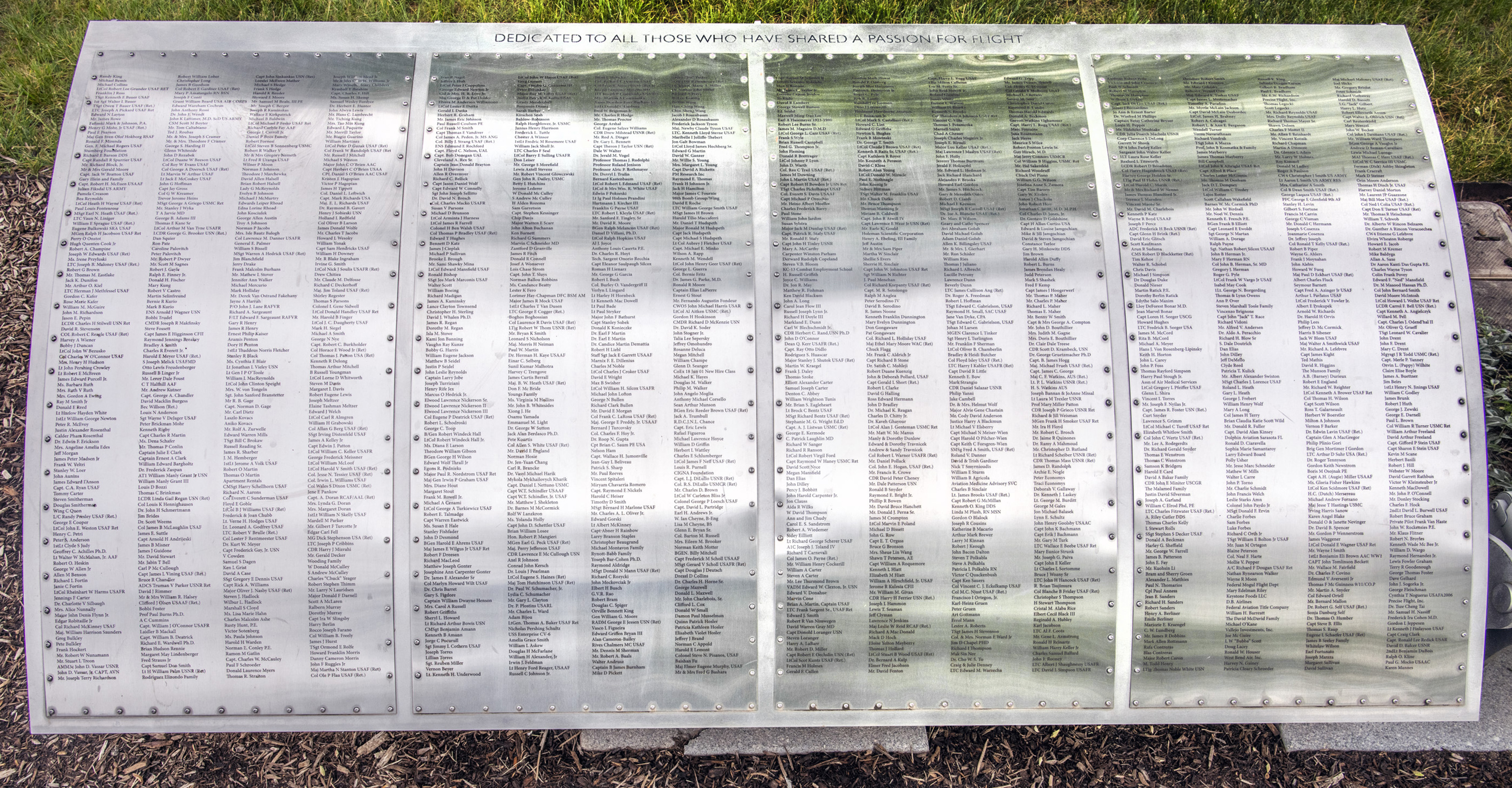Bennett D Katz
Foil: 3 Panel: 2 Column: 1 Line: 37
Wall of Honor Level: Air and Space Friend
Honored by:
Ms. Joyce K. Tapper
My student logbook shows that I began ground school on October 10, 1940, the day after my 22nd birthday. My first flight was just two days later at Muller Field in Revere, Massachusetts.
My instructor, Charles Hamilton, wrote that I did OK for the first time, taxiing cross wind and flying in straight and level flight. Several days later I got to try take-offs in my 60 horse Piper Cub. I should point out that Hamilton had two planes, one 60 hp and one 40 hp.
You might ask yourself whether your lawn mower was much more powerful.
After my 17th flight my logbook announced that I was ready to solo, and on October 25 I was adjudged to have done OK.
My first solo cross-country came on December 7 from Revere to Portland, Maine, where I landed feeling like a real big shot. The feeling didn't last long when I taxied around and took off for my return trip to Revere.
I soon noticed that cars driving south on the Newburyport Turnpike were passing me—I was bucking a stiff head wind. As I approached Plum Island, I began to have serious concerns as to whether I had enough gas to make it back to Revere. That is when I decided to make an unscheduled landing and phoned Revere—"help I need more gas!"
My logbook tells little else except that on December 19, 1940 I completed my instruction and passed my private's flight test. I had 24 hours of flying time including 15 hours of solo.
Watch out world! Here I come!
On December 31, 1940 I raised my hand and was sworn into the Army Air Corps— boarded a train for Darm Aero Tech in Albany, Georgia, and began my primary flight training. Of the 150 carefully screened candidates who began with me, I was one of only 60 who remained when basic training ended on March 15.
After more training at Montgomery Field in Alabama, I was graduated as a military pilot, and commissioned a Second Lieutenant on August 15, 1941 at Barksdale Field at Shreveport, Louisiana.
I was sent to the 4th Ferry Command at Long Beach, California and began to ferry new aircraft from California factories to wherever they were needed around the country—and thence around the world. It was a fascinating experience—a B17 to Australia, a B25 to North Africa, a P51 to Florida.
Editor's note: An obvious omission here involves not one but two flights over the "Burma hump". Katz's assignment was to deliver a plane to a U.S. base on the western side of the mountains. However, because of pilot shortages he was asked to make a run over the hump. Katz notes that of four planes sent out that day, only two returned. After making a second flight, he observed that the odds remained the same. Katz declined a third request.
A memorable flight was to take me from Topeka, Kansas to India in a brand new B24. It was a very short flight. The factory-fresh plane had two defective propellers, and I crashed moments after take-off in a wonderfully positioned soy bean field. I was uninjured, and though the plane caught fire it did not explode like so many B24s in previous crashes.
There were many less exciting flights after that, and by the time the war was over I had accumulated 2,631 hours of military flight time in 26 different types of aircraft including
Bombers B10, B12, B17, B18, B24, B25, B26 and B49
and fighters P51, P38
and trainers PT17, B15, AT6, AT7, AT8
and a variety of transports including DC3, C49, C50, C54, Lockheed
Constellations and Boeing Stratoliners, L1, L2, F24 and a few others.
By June 1946 I had my FAA instrument license and was enrolled in the airline pilot training program of American Overseas Airlines (AOA). AOA was one of three American carriers flying passengers across the north Atlantic to Britain, Ireland, Frankfort, Berlin, Amsterdam and the Scandinavian countries.
As a First Officer, I earned $550 a month plus a small increment based on hours flown. Our planes were mostly not pressurized. It was hard work for very small pay, but there was the promise of a new contract that would yield a living wage.
In July 1948 the Cold War got hot, and the Soviets rolled tanks across the road connecting Berlin with the American Zone—the so-called Berlin Corridor. This would effectively isolate Berlin and make it part of the Soviet Union. The U.S. clearly could not accept this, and we chose to create a steady airlift as an alternative.
I was transferred to Rhein-Main airport in Frankfurt, and as the single civilian aircraft we shuttled back and forth between Frankfurt and Berlin over the closed Berlin Corridor until the Soviets recanted and opened ground access.
In April of 1949 I had a very special passenger on board from Shannon to Frankfurt to LaGuardia—my mother, and it was a wonderful thrill for both of us.
By the end of October 1949 my flying days with AOA were over—interrupted by a bitter strike. I had over 5,000 hours of pilot time—and except for a few years of reserve military service, the story of Bennett Katz, Pilot, was over.
Wall of Honor profiles are provided by the honoree or the donor who added their name to the Wall of Honor. The Museum cannot validate all facts contained in the profiles.
Foil: 3
All foil images coming soon.View other foils on our Wall of Honor Flickr Gallery
